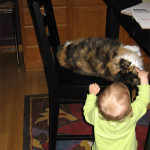 Last month’s commentary explored some basic concepts of ethology as they relate to human and animal behavior. This month I want to explore the ethology of the human-animal bond. I’m the first to admit that when I was younger, my views of the bond were shaped more by the media than science. As in the movies and news stories, at that time I believed there were good bonds and bad ones.
Last month’s commentary explored some basic concepts of ethology as they relate to human and animal behavior. This month I want to explore the ethology of the human-animal bond. I’m the first to admit that when I was younger, my views of the bond were shaped more by the media than science. As in the movies and news stories, at that time I believed there were good bonds and bad ones.
Relative to companion animals, a good bond meant the person loved the animal and, in animal terms, the animal felt the same way about the person. Strangely, bad bonds usually weren’t the opposite of good ones. More often than not, I perceived people who treated animals in ways I found offensive as morally flawed or even degenerate and their animals as hapless victims. To those like me who took this approach, these definitions were black and white. Conveniently, this approach required minimal to no knowledge of normal and problem animal behavior. But in my heart I knew it was true.
This orientation lasted until I took my first biology-based animal behavior course. Add more than four decades in veterinary medical or behavior/bond clinical practice and my view became a much broader, more ethological one. Somewhere in this process, I also experienced a most embarrassing light bulb moment. I realized that these relationships and the physiological and emotional bonds that result from these fall into the same categories as those experienced by those between animals of different species of any kind:
- Neither participant benefits nor loses anything from the interaction
- One benefits but the other does not.
- Neither benefit from the interaction.
- They both benefit.
This revelation embarrassed me because I saw daily evidence of this every time I observed or participated in a human-animal interaction. Even so, apparently I wasn’t ready to see it until that particular day.
Any and all of these 4 variations routinely may occur during our daily interactions with our own animal(s) as well as those wild and domestic ones we encounter when we’re out and about. Like all of nature they’re part of a dynamic continuum and none is inherently “wrong” to the others’ “right”. However the emotional charges we and the animal(s) place on these interactions and the physiological changes associated with these define the exact nature of the bond at that time.
Let’s look at some examples of how these play out.
Neither the person nor the animal benefits or loses anything from the interaction
If neither the person nor the animal benefits or loses from the interaction, does this mean that no bond exists? No, at least not on the physiological level. Particularly in westernized industrial cultures, there are people of all ages who normally are oblivious to any animals around them. Humans establish their homes and work environments, and fulfill their basic needs–which may include mating, reproduction, raising offspring, playing and eventually dying–all while remaining unmindful of the presence of members of other species in that same environment. Meanwhile any animals in that same environment go about their lives as if those people didn’t exist either.
But even if we and any animals don’t consciously acknowledge each others’ existence, our combined presence nonetheless changes our shared micro-environment. We breathe the same air and when we exhale, we each add our own unique signatures to that air (including our microbes like bacteria and viruses) that they and we then inhale again. The fact that some animals are capable of transmitting diseases to us and we to them further reminds us of this most basic biochemical bond that exists whether we choose to acknowledge its presence or not.
The person or the animal benefits but the other does not
I don’t know whether these bonds truly represent the most common ones between humans and wild animals or just the ones most commonly reported by the media because they lend themselves so readily to polarizing villain-victim scenarios. Trophy-hunters bag bragging rights; animals die in the process. Insects swoop down and wipe out crops; people lose their incomes or even their only food source.

People and companion animals who share their lives also may experience more lop-sided bonds on occasion or as a constant state of their in their interactions. A fairly common example of the former are those situations in which we take the animal somewhere where the animal doesn’t want to go—the veterinary clinic, groomers, a noisy public gathering or event—or force more fearful Fido to “kiss” highly reactive Aunt Gushy even though doing so terrifies him. Or at the opposite end of that same spectrum, we leave the dog home who wants to come with us when there’s really no good reason why we should. Then there’s that growing population of folks who force their pets to function as service or therapy animals for their own (human) gratification even though the animals lack the training, breeding, or temperament to do this.
But while there are times when human desires take precedence over the animals’, there also are times when the balance shifts in the opposite direction. Some unfortunate souls adopt or rescue animals whose physical and behavioral demands literally take over their lives to the point it literally destroys their own health and well-being. On a more mundane level, many a dog owner has found him- or herself standing in the freezing rain waiting while Fidocia locates the exact square foot of ground she considers worthy of her urine or stool.
Neither human nor animal benefits from the interaction
 The many examples of human destruction of the natural environment with no thought given to the consequences for the wild animals living in that habit serves as a familiar example not usually coached in terms of loss to humans too. Admittedly removing all the trees and filling in any wetlands makes it easier to build faster which in short-term calculations makes it appear more cost-effective. But as increasing numbers of studies point out, the long-term negative effects on human as well as animal welfare cancel these out.
The many examples of human destruction of the natural environment with no thought given to the consequences for the wild animals living in that habit serves as a familiar example not usually coached in terms of loss to humans too. Admittedly removing all the trees and filling in any wetlands makes it easier to build faster which in short-term calculations makes it appear more cost-effective. But as increasing numbers of studies point out, the long-term negative effects on human as well as animal welfare cancel these out.
Human-companion animal bonds that succumb to this fate more commonly are associated with animals received as unsolicited gifts or those purchased/adopted for impulsive emotion-based reasons. In the former case, the person winds up with an animal he or she might never have chosen or chosen to have at that particular time. In the latter, the person succumbs to buyer’s regret when the animal doesn’t live up to expectations. If these people then choose to keep the animal because they don’t dare upset the source for some reason or are afraid to admit that they made a mistake, the animal becomes a constant reminder of their shortcomings.
As often occurs in the behavioral realm, people may respond in quite opposite ways to these unwanted animals. Some may provide the basics, but no more. Others may feel guilty about their feelings and go overboard with special foods and treats that undermine the animal’s health and behavior to compensate for their lack of emotional commitment. But because that connection isn’t there no matter how much money they spend, they can’t summon the effort necessary to generate lasting changes to ensure a mutually rewarding bond.
Meanwhile the animals in these relationships are coming from the same place. They never would have chosen to live with someone who doesn’t want them, either. Other times people who choose impulsively but with the best of intentions may wind up with an animal who doesn’t want to live with any person and especially not in a confined space like a house or apartment. Like those people whose positive feelings about the animal quickly begin to wane, these animals may find that the strong attraction of a free-roaming life sans human interference makes summoning the energy to adjust to life as a house pet not worth the effort.
Human and animal both benefit
It goes without saying that such bonds represent or should represent the goal of every human-animal interaction or, if that isn’t possible for some reason, that goal should trigger a desire to limit any costs to both participants as much as possible.
Does this mean that we and the animals with whom we share an environment feel all gooey about each other all of the time? Hardly. Such a view is too simplistic. If and how much of the bond’s existence an  individual human or animal consciously recognizes and the value
individual human or animal consciously recognizes and the value each assigns to it is most likely a function of the familiar triad: genetic and epigenetic factors plus experience. Children exposed to the natural world at an early age will perceive more of these connections than those who don’t have this opportunity. That doesn’t mean that older kids and adults can’t develop this perception. But like many other skills it takes more effort to gain it as one gets older. Similarly young animals of many species exposed to quality interactions with people will perceive more of these connections than those who have lacked this experience.
each assigns to it is most likely a function of the familiar triad: genetic and epigenetic factors plus experience. Children exposed to the natural world at an early age will perceive more of these connections than those who don’t have this opportunity. That doesn’t mean that older kids and adults can’t develop this perception. But like many other skills it takes more effort to gain it as one gets older. Similarly young animals of many species exposed to quality interactions with people will perceive more of these connections than those who have lacked this experience.
The good news is that most people and animals who share mutually beneficial relationships also share a sometimes subliminal but always mutually beneficial baseline bond. Most people become aware of this connection when they and their animals share the same physical environment while their conscious minds are somewhere else. For example, there are times when I walk back up to the house from the mailbox that I’m so engrossed in the mail that nothing registers except what I’m reading. At the same time, the birds and small critters are so engrossed in their activities that they ignore me too, as do the dogs and cat who typically make this daily trip with me. On the other hand, because we somehow share the same mental and physiologically environment as well as physical environment, were the others not there we would notice.
Or consider the human-canine situation I currently experience when I write. As I simultaneously attempt master a new computer and software (not an easy task for me!) and write something meaningful, I intuitively know the dogs are in the office somewhere. I assume that they’re sleeping on one of the 3 pet beds in the room, although I’ve been so engrossed in my work I can’t say that for sure. It’s possible that one of both may be in my bedroom or on the chair or futon in the library. Even so I know we’re connected because I feel it. There’s no need to confirm this observation any more than for them to alert me to their presence. They feel secure enough in the physiological and mental web of mutual trust that connects us that they sleep soundly, ignoring the passing of vehicles on the road below the house and other sounds that would interest them if I were more outwardly engaged myself.
I’m sure many of you experience or have experienced such feelings of connection with animals too because it adds another dimension to your life and the lens through which you perceive your surroundings. It’s real, and it makes the world a better place for human and animal alike.
Relative to companion animals, a good bond meant the person loved the animal and, in animal terms, the animal felt the same way about the person. Strangely, bad bonds usually weren’t the opposite of good ones. More often than not, I perceived people who treated animals in ways I found offensive as morally flawed or even degenerate and their animals as hapless victims. To those like me who took this approach, these definitions were black and white. Conveniently, this approach required minimal to no knowledge of normal and problem animal behavior. But in my heart I knew it was true.
This orientation lasted until I took my first biology-based animal behavior course. Add more than four decades in veterinary medical or behavior/bond clinical practice and my view became a much broader, more ethological one. Somewhere in this process, I also experienced a most embarrassing light bulb moment. I realized that these relationships and the physiological and emotional bonds that result from these fall into the same categories as those experienced by those between animals of different species of any kind:
This revelation embarrassed me because I saw daily evidence of this every time I observed or participated in a human-animal interaction. Even so, apparently I wasn’t ready to see it until that particular day.
Any and all of these 4 variations routinely may occur during our daily interactions with our own animal(s) as well as those wild and domestic ones we encounter when we’re out and about. Like all of nature they’re part of a dynamic continuum and none is inherently “wrong” to the others’ “right”. However the emotional charges we and the animal(s) place on these interactions and the physiological changes associated with these define the exact nature of the bond at that time.
Let’s look at some examples of how these play out.
Neither the person nor the animal benefits or loses anything from the interaction
If neither the person nor the animal benefits or loses from the interaction, does this mean that no bond exists? No, at least not on the physiological level. Particularly in westernized industrial cultures, there are people of all ages who normally are oblivious to any animals around them. Humans establish their homes and work environments, and fulfill their basic needs–which may include mating, reproduction, raising offspring, playing and eventually dying–all while remaining unmindful of the presence of members of other species in that same environment. Meanwhile any animals in that same environment go about their lives as if those people didn’t exist either.
But even if we and any animals don’t consciously acknowledge each others’ existence, our combined presence nonetheless changes our shared micro-environment. We breathe the same air and when we exhale, we each add our own unique signatures to that air (including our microbes like bacteria and viruses) that they and we then inhale again. The fact that some animals are capable of transmitting diseases to us and we to them further reminds us of this most basic biochemical bond that exists whether we choose to acknowledge its presence or not.
The person or the animal benefits but the other does not
I don’t know whether these bonds truly represent the most common ones between humans and wild animals or just the ones most commonly reported by the media because they lend themselves so readily to polarizing villain-victim scenarios. Trophy-hunters bag bragging rights; animals die in the process. Insects swoop down and wipe out crops; people lose their incomes or even their only food source.
People and companion animals who share their lives also may experience more lop-sided bonds on occasion or as a constant state of their in their interactions. A fairly common example of the former are those situations in which we take the animal somewhere where the animal doesn’t want to go—the veterinary clinic, groomers, a noisy public gathering or event—or force more fearful Fido to “kiss” highly reactive Aunt Gushy even though doing so terrifies him. Or at the opposite end of that same spectrum, we leave the dog home who wants to come with us when there’s really no good reason why we should. Then there’s that growing population of folks who force their pets to function as service or therapy animals for their own (human) gratification even though the animals lack the training, breeding, or temperament to do this.
But while there are times when human desires take precedence over the animals’, there also are times when the balance shifts in the opposite direction. Some unfortunate souls adopt or rescue animals whose physical and behavioral demands literally take over their lives to the point it literally destroys their own health and well-being. On a more mundane level, many a dog owner has found him- or herself standing in the freezing rain waiting while Fidocia locates the exact square foot of ground she considers worthy of her urine or stool.
Neither human nor animal benefits from the interaction
Human-companion animal bonds that succumb to this fate more commonly are associated with animals received as unsolicited gifts or those purchased/adopted for impulsive emotion-based reasons. In the former case, the person winds up with an animal he or she might never have chosen or chosen to have at that particular time. In the latter, the person succumbs to buyer’s regret when the animal doesn’t live up to expectations. If these people then choose to keep the animal because they don’t dare upset the source for some reason or are afraid to admit that they made a mistake, the animal becomes a constant reminder of their shortcomings.
As often occurs in the behavioral realm, people may respond in quite opposite ways to these unwanted animals. Some may provide the basics, but no more. Others may feel guilty about their feelings and go overboard with special foods and treats that undermine the animal’s health and behavior to compensate for their lack of emotional commitment. But because that connection isn’t there no matter how much money they spend, they can’t summon the effort necessary to generate lasting changes to ensure a mutually rewarding bond.
Meanwhile the animals in these relationships are coming from the same place. They never would have chosen to live with someone who doesn’t want them, either. Other times people who choose impulsively but with the best of intentions may wind up with an animal who doesn’t want to live with any person and especially not in a confined space like a house or apartment. Like those people whose positive feelings about the animal quickly begin to wane, these animals may find that the strong attraction of a free-roaming life sans human interference makes summoning the energy to adjust to life as a house pet not worth the effort.
Human and animal both benefit
It goes without saying that such bonds represent or should represent the goal of every human-animal interaction or, if that isn’t possible for some reason, that goal should trigger a desire to limit any costs to both participants as much as possible.
Does this mean that we and the animals with whom we share an environment feel all gooey about each other all of the time? Hardly. Such a view is too simplistic. If and how much of the bond’s existence an individual human or animal consciously recognizes and the value
individual human or animal consciously recognizes and the value each assigns to it is most likely a function of the familiar triad: genetic and epigenetic factors plus experience. Children exposed to the natural world at an early age will perceive more of these connections than those who don’t have this opportunity. That doesn’t mean that older kids and adults can’t develop this perception. But like many other skills it takes more effort to gain it as one gets older. Similarly young animals of many species exposed to quality interactions with people will perceive more of these connections than those who have lacked this experience.
each assigns to it is most likely a function of the familiar triad: genetic and epigenetic factors plus experience. Children exposed to the natural world at an early age will perceive more of these connections than those who don’t have this opportunity. That doesn’t mean that older kids and adults can’t develop this perception. But like many other skills it takes more effort to gain it as one gets older. Similarly young animals of many species exposed to quality interactions with people will perceive more of these connections than those who have lacked this experience.
The good news is that most people and animals who share mutually beneficial relationships also share a sometimes subliminal but always mutually beneficial baseline bond. Most people become aware of this connection when they and their animals share the same physical environment while their conscious minds are somewhere else. For example, there are times when I walk back up to the house from the mailbox that I’m so engrossed in the mail that nothing registers except what I’m reading. At the same time, the birds and small critters are so engrossed in their activities that they ignore me too, as do the dogs and cat who typically make this daily trip with me. On the other hand, because we somehow share the same mental and physiologically environment as well as physical environment, were the others not there we would notice.
Or consider the human-canine situation I currently experience when I write. As I simultaneously attempt master a new computer and software (not an easy task for me!) and write something meaningful, I intuitively know the dogs are in the office somewhere. I assume that they’re sleeping on one of the 3 pet beds in the room, although I’ve been so engrossed in my work I can’t say that for sure. It’s possible that one of both may be in my bedroom or on the chair or futon in the library. Even so I know we’re connected because I feel it. There’s no need to confirm this observation any more than for them to alert me to their presence. They feel secure enough in the physiological and mental web of mutual trust that connects us that they sleep soundly, ignoring the passing of vehicles on the road below the house and other sounds that would interest them if I were more outwardly engaged myself.
I’m sure many of you experience or have experienced such feelings of connection with animals too because it adds another dimension to your life and the lens through which you perceive your surroundings. It’s real, and it makes the world a better place for human and animal alike.